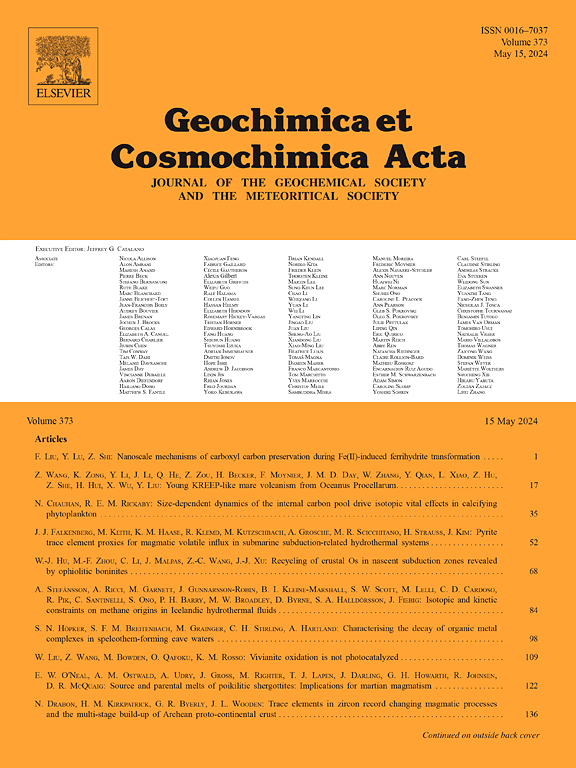Effect of temperature on 2H/1H fractionation in semi-continuous cultures of a marine diatom, coccolithophore, and dinoflagellate
IF 4.5
1区 地球科学
Q1 GEOCHEMISTRY & GEOPHYSICS
引用次数: 0
Abstract
Temperature regulates the metabolic rate of organisms and, together with salinity, determines seawater density, a key driver of ocean circulation and heat transport. The hydrogen isotope composition (2H/1H) of phytoplankton lipids has been shown to vary systematically with salinity and applied as a paleosalinity proxy in marine sediments. The influence of temperature on 2H/1H ratios of lipids from different phytoplankton groups remains poorly constrained, especially when other growth parameters known to influence 2H/1H fractionation are held constant, such as growth rate, irradiance, and salinity. We investigated 2H/1H ratios responses of lipid biomarkers (fatty acids (FAs), sterols and alkenones) to temperature (12 ∼ 27 °C) in three marine phytoplankton taxa, the diatom Phaeodactylum tricornutum, the dinoflagellate Prorocentrum donghaiense, and the coccolithophorid Emiliania huxleyi using semi-continuous cultures. We show that 2H/1H fractionation of FAs in the dinoflagellate decreased by 2.2 ± 0.3 ‰ °C–1 (p < 0.05), while that of sterols in the dinoflagellate and fatty acid C14:0 in the diatom increased by 2.3 ‰ °C–1 and 1.9 ‰ °C–1 (p < 0.05), respectively, as temperature increased. 2H/1H fractionation of the three types of lipids in the coccolithophores did not vary systematically with temperature. The underlying mechanism by which temperature alters lipid 2H/1H fractionation likely involves its effect on the proportions of photosynthetic and metabolic NADPH incorporated into lipids, NADPH residence time in the chloroplast, the contribution of extra-plastidic pyruvate to FA synthesis, and the proportion of mevalonic acid- versus methylerythritol phosphate-derived precursors in sterols.
求助全文
约1分钟内获得全文
求助全文
来源期刊

Geochimica et Cosmochimica Acta
地学-地球化学与地球物理
CiteScore
9.60
自引率
14.00%
发文量
437
审稿时长
6 months
期刊介绍:
Geochimica et Cosmochimica Acta publishes research papers in a wide range of subjects in terrestrial geochemistry, meteoritics, and planetary geochemistry. The scope of the journal includes:
1). Physical chemistry of gases, aqueous solutions, glasses, and crystalline solids
2). Igneous and metamorphic petrology
3). Chemical processes in the atmosphere, hydrosphere, biosphere, and lithosphere of the Earth
4). Organic geochemistry
5). Isotope geochemistry
6). Meteoritics and meteorite impacts
7). Lunar science; and
8). Planetary geochemistry.
 求助内容:
求助内容: 应助结果提醒方式:
应助结果提醒方式:


